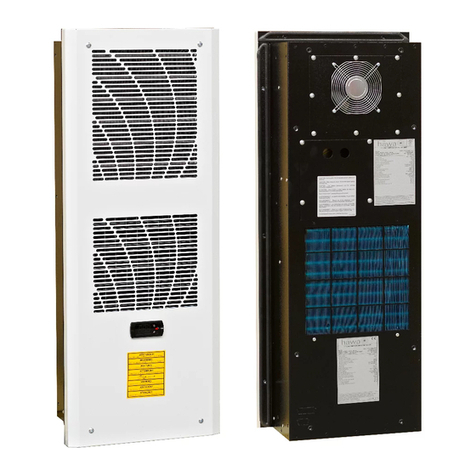
7
13. Betriebsstörungen – Ursachen – Abhilfen
Übermäßige Kondenswasserbildung
• Schaltschrank mit Schutzgrad unter IP54
- Kontrollieren, dass die Klebedichtung zwischen dem Kühlgerät und dem Schaltschrank korrekt angebracht wurde.
- Kontrollieren, dass es keine Öffnungen in den Schränken gibt.
Keine ausreichende Kühlung
• Der Innenventilator funktioniert, Kompressor und Außenventilator funktionieren unregelmäßig
- Auslösen des Frostschutzthermostats > Verdampferreinigung prüfen, ob eventuell externe Ursachen den
Luftstrom im internen Kreislauf behindern (optional)
- Auslösen des Niederdruckwächters > Unzureichende Kühlmittelmenge im Kühlmittelkreis
- den Kühltechniker oder techn. Kundendienst von häwa GmbH befragen
• Kondensatorventilator und der Verdampferventilator funktionieren, der Kompressor funktioniert unregelmäßig
- Auslösen des Hochdruckwächters > Raumtemperatur über dem maximal zugelassenen Wert (siehe Typenschild)
- den Raum lüften
- den Kühltechniker oder techn. Kundendienst von häwa GmbH befragen
> Verschmutzte Filtermatte
- den verschmutzten Filter reinigen oder bei Bedarf ersetzen
> Verschmutzter Kondensator
- den Kondensator reinigen
> Kurzschluss der Luft
- Überprüfen, dass es keine Verstopfungen oder Hindernisse gibt, die das
Ausblasen der Luft verhindern.
- Überprüfen, dass die in diesem Handbuch angeführten Mindestabstände
von den Wänden, der Decke bzw. einem weiteren Schaltschrank oder
Kühlgerät eingehalten sind.
- Auslösen des thermischen Kompressorschutzes > Lufttemperatur im Schrank über dem maximal zugelassenen Wert
> Verschmutzte Filtermatte s. o.
> Verschmutzter Kondensator s. o.
> Kurzschluss der Luft s. o.
• Der Innenventilator funktioniert, der Außenventilator funktioniert nicht, der Kompressor funktioniert unregelmäßig
- Elektrischer Kondensatorlüfter defekt
> Den Kondensator für Lüfter ersetzen
- Außenventilator defekt
> Den defekten Außenventilator ersetzen
Keine Kühlung
• Keine Komponente funktioniert
- Das Gerät wird nicht mit Spannung versorgt > Überprüfen, ob die Türen und Schalter geschlossen sind
• Kompressor, Kondensatorventilator und Verdampferventilator funktionieren
- Kein Kühlmittel in der Kühlanlage > Den Kühltechniker oder technischen Kundendienst von häwa GmbH befragen
- Mechanischer Schaden > Den Kühltechniker oder technischen Kundendienst von häwa GmbH befragen
• Kompressor und der Außenventilator funktionieren, der Innenventilator funktioniert nicht
- Der elektrische Lüfterkondensator funktioniert nicht > Den elektrischen Kondensator für den Lüfter ersetzen
- Verdampferventilator defekt > Den Ventilator ersetzen
• Außen- und Innenventilator funktionieren, der Kompressor funktioniert nicht
- Schaden am thermo-amperometrischen Schutz des Kompressors (falls vorhanden)
> Den thermo-amperometrischen Schutz ersetzen und die Funktion der elektrischen Kompressorkomponenten
überprüfen
- Schaden am Anlaufrelais/Startrelais des Kompressors > Anlaufrelais/Startrelais des Kompressors ersetzen
- Schaden am Anlaufkondensator des Kompressors (falls vorhanden) > Den Anlaufkondensator ersetzen
- Kompressormotor defekt > Den Kühltechniker oder technischen Kundendienst von häwa GmbH befragen
- Hochdruckwächter defekt > Den Kühltechniker oder technischen Kundendienst von häwa GmbH befragen
- Kompressorfernschalter (falls vorhanden) defekt > Den Fernschalter ersetzen
• Innen- und Außenventilator sowie Kompressor funktionieren
- Regelthermostat defekt oder auf eine höhere Temperatur eingestellt als diejenige im Schrank




























